Heirloom Plants: Learn About Growing Jing Orange Okra


Gardeners in hot climates love the okra plant, and for good reason - it seems like no amount of heat can kill it. If you're an okra fan but you want something a little different and exciting, then Jing Orange is for you. This Asian heirloom produces pods in a spectacular shade of fire engine red. And they taste pretty great, too.
What is Jing Orange Okra?
Jing Orange okra (Abelmoschus esculentus) is an heirloom variety that hails from Asia. It is very tolerant of dry and hot conditions. It may be a little slow to get started, but once it hits its stride, it's extremely prolific. Some gardeners report being overwhelmed by okra pods, but that's not really a bad thing, is it? The pods can reach 5 to 9 inches (13-23 cm.) in length, but they're best eaten if they're picked young at about 3 inches (8 cm.). The pods are very tender and spineless and aren't unpleasant even if eaten at their mature size. They have a great okra flavor and, most importantly, a remarkable bright color of deep orange to bright red. Be aware, though, that when cooked or pickled, the pods tend to lose their distinctive color and fade to a more traditional green.
Growing Jing Orange Okra
Jing Orange okra plants are tolerant of heat, but they're not cold hardy. If your climate experiences frost, start the seeds indoors about a month before the last spring frost, and don't transplant seedlings outside until the soil has warmed to at least 65 F. (18 C.). While they're very tasty, the plants can just as easily be grown as ornamentals - between the bright red pods and the yellow to white blossoms with red accents, they have a really striking appearance suitable for any flower garden. The stems and pods can also be dried at the end of the growing season for a great, colorful addition to dried flower arrangements.
Gardening tips, videos, info and more delivered right to your inbox!
Sign up for the Gardening Know How newsletter today and receive a free download of our most popular eBook "How to Grow Delicious Tomatoes."

The only child of a horticulturist and an English teacher, Liz Baessler was destined to become a gardening editor. She has been with Gardening Know how since 2015, and a Senior Editor since 2020. She holds a BA in English from Brandeis University and an MA in English from the University of Geneva, Switzerland. After years of gardening in containers and community garden plots, she finally has a backyard of her own, which she is systematically filling with vegetables and flowers.
-
 7 Best Dwarf Tomato Plants
7 Best Dwarf Tomato PlantsHave a tiny growing space? Look for dwarf tomato seeds so you don’t miss out on summer’s juicy bounty.
By Susan Albert
-
 5 Night-Blooming Houseplants – Grow An Indoor Moon Garden
5 Night-Blooming Houseplants – Grow An Indoor Moon GardenThere is something uniquely special about night-blooming houseplants. Set the scene for a magical evening indoors with these fragrant flowering beauties.
By Amy Grant